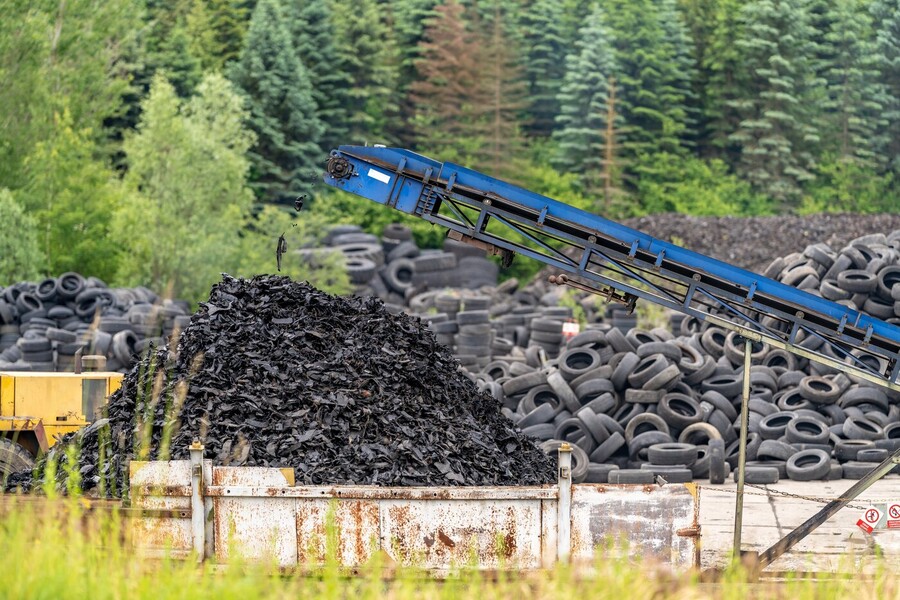By Rachel Massey, ScD and Zhenyu Tian, PhD
Waste tires are used in a variety of applications, including widespread use as recreational surfacing. This includes artificial turf and “rubber mulch” marketed for use in gardens and on playgrounds. These products are marketed as a solution to the problem of burgeoning tire waste, but they disperse waste material widely into the environment, creating a future cleanup problem. And they create the conditions for young children to be exposed to this problematic material.
Waste tires contain hundreds of chemicals – including intentionally added chemicals, unintentional byproducts of manufacturing, and chemicals accumulated during use. Many of these chemicals pose health concerns. The EU has taken action to address some of the hazards associated with use of tire materials in recreational surfacing, for example by adopting a restriction on polyaromatic hydrocarbons (PAHs) in tire crumb used in artificial turf.
One chemical that is a source of increasing concern is 6-p-phenylenediamine (6PPD). 6PPD is an antiozonant used in tire manufacturing – its function is to react with atmospheric ozone, protecting the rubber polymers from degradation. When it reacts with ozone, 6PPD forms the transformation product 6PPD-quinone.
A newly understood hazard
Some chemical hazards have been understood for many years, but the hazards of 6PPD-quinone have been uncovered just in the past few years as a group of scientists worked to solve the mystery of periodic die-offs of coho salmon. After significant rain events, coho salmon were found gaping, swimming in uncontrolled patterns, and dying in the creeks and rivers of the Pacific Northwest. The coho salmon died before spawning, creating a severe threat to the coho population over time.
Based on the correlation of coho pre-spawn mortality and traffic intensities, the researchers hypothesized that a component of road run-off was to blame. They exposed coho salmon to tire rubber leachate and confirmed the lethal effects of the contaminated water. They gradually narrowed down the set of possible chemicals in this leachate that might be responsible, and eventually zeroed in on 6PPD-quinone as the culprit. You can learn more about the research in Dr. Zhenyu Tian’s portion of this webinar, and read more about it here.
6PPD-quinone is not equally toxic to all species. A study found the chemical can be lethal to rainbow and brook trout, while arctic char and sturgeon may not be affected. Atlantic salmon and brown trout seem to be all right. The mechanism of toxicity may be related to disruption of the blood-brain barrier (see more background information here).
What about people? A 2022 study conducted in China found both 6PPD and 6PPD-quinone in urine samples from adults, children, and pregnant women. As summarized by the authors:
“Considering that 6PPD-Q was a lethal toxicant to multiple aquatic species, the potential human health risks posed by its long-term exposure require urgent attention.”
Many risk assessments have examined the possible health implications of children’s exposure to waste tires in recreational settings, drawing a variety of conclusions. Since 6PPD-quinone was only recently identified as a concern, it was not taken into account in these assessments.
Other recent research has documented the presence of 6PPD-quinone and related chemicals in “urban runoff, roadside soils, and air particles.”
Markets for waste tires
As scientific knowledge on 6PPD-quinone and other PPD-quinones continues to develop, and as the effort to find safer alternatives gathers steam, there continues to be an active market in waste tire materials. A 2022 tweet from the US Tire Manufacturers Association highlights the drive to find more uses for waste tires:
“Our new Scrap Tire Management Report reveals there are opportunities to expand end-use tire markets and improve tire recycling rates to keep pace with annual scrap tire generation.”
And a 2022 article in Recycling Today notes a need for more ways to use waste tires, as well as the growing role of mulch and playground surfacing in meeting this need:
“Rubber mulch increased use by 54 percent in 2021 compared with 2019, consuming 391,000 tons of scrap tires. USTMA estimates that home improvement activities during COVID-19-related shutdowns helped to increase use in this area."
If you take a quick look on your favorite online shopping site you’ll readily see opportunities to buy tire waste in garden mulch and tire waste for playground surfacing.
Addressing 6PPD in tires
Some efforts are under way to address 6PPD at the state level.
California’s Department of Toxic Substances Control has proposed the designation of tires containing 6PPD as a Priority Product under its Safer Consumer Products Regulation (see California DTSC’s short video explainer here). Under this designation, tire manufacturers would be required to seek safer alternatives to 6PPD in tires. The Washington Department of Ecology, meanwhile, has brought together a wide spectrum of stakeholders, including tire manufacturers, to search together for a safer alternative.
6PPD is a concern anywhere tires are used. In a best case scenario, a safer and effective alternative will be identified and adopted rapidly for new tire manufacturing. The problem of 6PPD in existing tires, however, remains. A common sense step we can take is to avoid unnecessary additional exposure, by avoiding use of these waste materials in spaces where young children play.
This blog is the second in a series on artificial turf, playground surfacing, and safer alternatives. Also see:
- Playing on Plastic: Artificial Turf Hazards and Safer Alternatives
- Playground Surfacing: Fun and safety without toxic chemicals
- Forever Chemicals in Artificial Turf: Understanding PFAS testing
 Rachel Massey, ScD is Senior Science and Policy Advisor at the Collaborative for Health and Environment and Senior Research Associate at the Lowell Center for Sustainable Production at the University of Massachusetts Lowell. She has worked at the intersection of public interest science and policy making in state, national and international arenas. Prior to joining CHE she served as Senior Associate Director at the Massachusetts Toxics Use Reduction Institute.
Rachel Massey, ScD is Senior Science and Policy Advisor at the Collaborative for Health and Environment and Senior Research Associate at the Lowell Center for Sustainable Production at the University of Massachusetts Lowell. She has worked at the intersection of public interest science and policy making in state, national and international arenas. Prior to joining CHE she served as Senior Associate Director at the Massachusetts Toxics Use Reduction Institute.
 Zhenyu Tian, PhD is an assistant professor at Northeastern University. He received his Ph.D. from UNC-Chapel Hill, and worked as a postdoc research scientist at the University of Washington Tacoma. His research uses cutting edge methods in analytical chemistry, toxicology, and data analysis to identify emerging organic contaminants in the environment.
Zhenyu Tian, PhD is an assistant professor at Northeastern University. He received his Ph.D. from UNC-Chapel Hill, and worked as a postdoc research scientist at the University of Washington Tacoma. His research uses cutting edge methods in analytical chemistry, toxicology, and data analysis to identify emerging organic contaminants in the environment.

